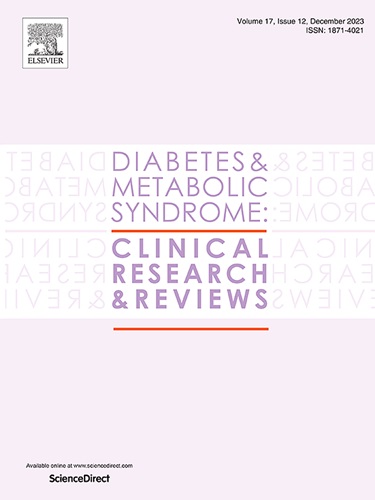The association between clock gene polymorphisms and type 2 diabetes: A systematic review and meta-analysis
IF 3.4
Q1 ENDOCRINOLOGY & METABOLISM
Diabetes & Metabolic Syndrome-Clinical Research & Reviews
Pub Date : 2025-07-01
DOI:10.1016/j.dsx.2025.103284
引用次数: 0
Abstract
Background
Misalignment of the endogenous circadian system may contribute to the risk of type 2 diabetes. This systematic review and meta-analysis examined the association between clock gene polymorphisms and glycemic parameters and type 2 diabetes.
Methods
Embase, Medline, and Web of Science databases were searched from inception to August 20, 2024. Empirical studies examining the association between core clock gene polymorphisms and type 2 diabetes and glycemic parameters, and studies examining non-core clock genes with information on environmental factors were included. A multi-level meta-analytical approach was used, and a weighted odds ratio was reported (PROSPERO, CRD42022337706).
Results
In total, 37 studies comprising 535,063 participants were included. CRY2 was associated with higher fasting blood glucose (OR: 1.07, 95 % CI: 1.03–1.11) and impaired glucose tolerance (OR: 1.02, CI: 1.00–1.04). Polymorphisms in MTNR1B were associated with a greater risk of type 2 diabetes. CLOCK was associated with lower risk of type 2 diabetes (OR: 0.94, CI: 0.89–1.00), and PER3 was associated with lower fasting insulin (OR: 0.94, CI: 0.91–0.97) and lower risk of insulin resistance (OR: 0.92, CI: 0.88–0.95). These associations reflect pooled variant-level effects within genes, and the effects of certain variants were modified by diet, alcohol consumption, physical activity, sleep, and length of daylight.
Conclusions
Specific polymorphisms in circadian genes, including CRY2, MTNR1B, CLOCK, and PER3, were associated with glycemic parameters and type 2 diabetes risk. These associations may be influenced by lifestyle and environmental factors, and interventions targeting circadian alignment could potentially modify diabetes risk, although further research is needed.
时钟基因多态性与2型糖尿病之间的关系:一项系统综述和荟萃分析
背景:内源性昼夜节律系统的失调可能会增加2型糖尿病的风险。本系统综述和荟萃分析研究了时钟基因多态性与血糖参数和2型糖尿病之间的关系。方法检索sembase、Medline和Web of Science数据库,检索时间为成立至2024年8月20日。包括核心时钟基因多态性与2型糖尿病和血糖参数相关性的实证研究,以及具有环境因素信息的非核心时钟基因的实证研究。采用多层次荟萃分析方法,并报告加权优势比(PROSPERO, CRD42022337706)。结果共纳入37项研究,535,063名受试者。CRY2与较高的空腹血糖(OR: 1.07, 95% CI: 1.03-1.11)和糖耐量受损(OR: 1.02, CI: 1.00-1.04)相关。MTNR1B的多态性与2型糖尿病的高风险相关。CLOCK与较低的2型糖尿病风险相关(OR: 0.94, CI: 0.89-1.00), PER3与较低的空腹胰岛素相关(OR: 0.94, CI: 0.91-0.97)和较低的胰岛素抵抗风险相关(OR: 0.92, CI: 0.88-0.95)。这些关联反映了基因中汇总的变异水平效应,并且某些变异的影响被饮食、饮酒、体育活动、睡眠和日照长度所改变。结论:昼夜节律基因CRY2、MTNR1B、CLOCK和PER3的特异性多态性与血糖参数和2型糖尿病风险相关。这些关联可能受到生活方式和环境因素的影响,针对昼夜节律调整的干预措施可能会潜在地改变糖尿病风险,尽管还需要进一步的研究。
本文章由计算机程序翻译,如有差异,请以英文原文为准。
求助全文
约1分钟内获得全文
求助全文
来源期刊

Diabetes & Metabolic Syndrome-Clinical Research & Reviews
ENDOCRINOLOGY & METABOLISM-
CiteScore
22.90
自引率
2.00%
发文量
248
审稿时长
51 days
期刊介绍:
Diabetes and Metabolic Syndrome: Clinical Research and Reviews is the official journal of DiabetesIndia. It aims to provide a global platform for healthcare professionals, diabetes educators, and other stakeholders to submit their research on diabetes care.
Types of Publications:
Diabetes and Metabolic Syndrome: Clinical Research and Reviews publishes peer-reviewed original articles, reviews, short communications, case reports, letters to the Editor, and expert comments. Reviews and mini-reviews are particularly welcomed for areas within endocrinology undergoing rapid changes.
 求助内容:
求助内容: 应助结果提醒方式:
应助结果提醒方式:


